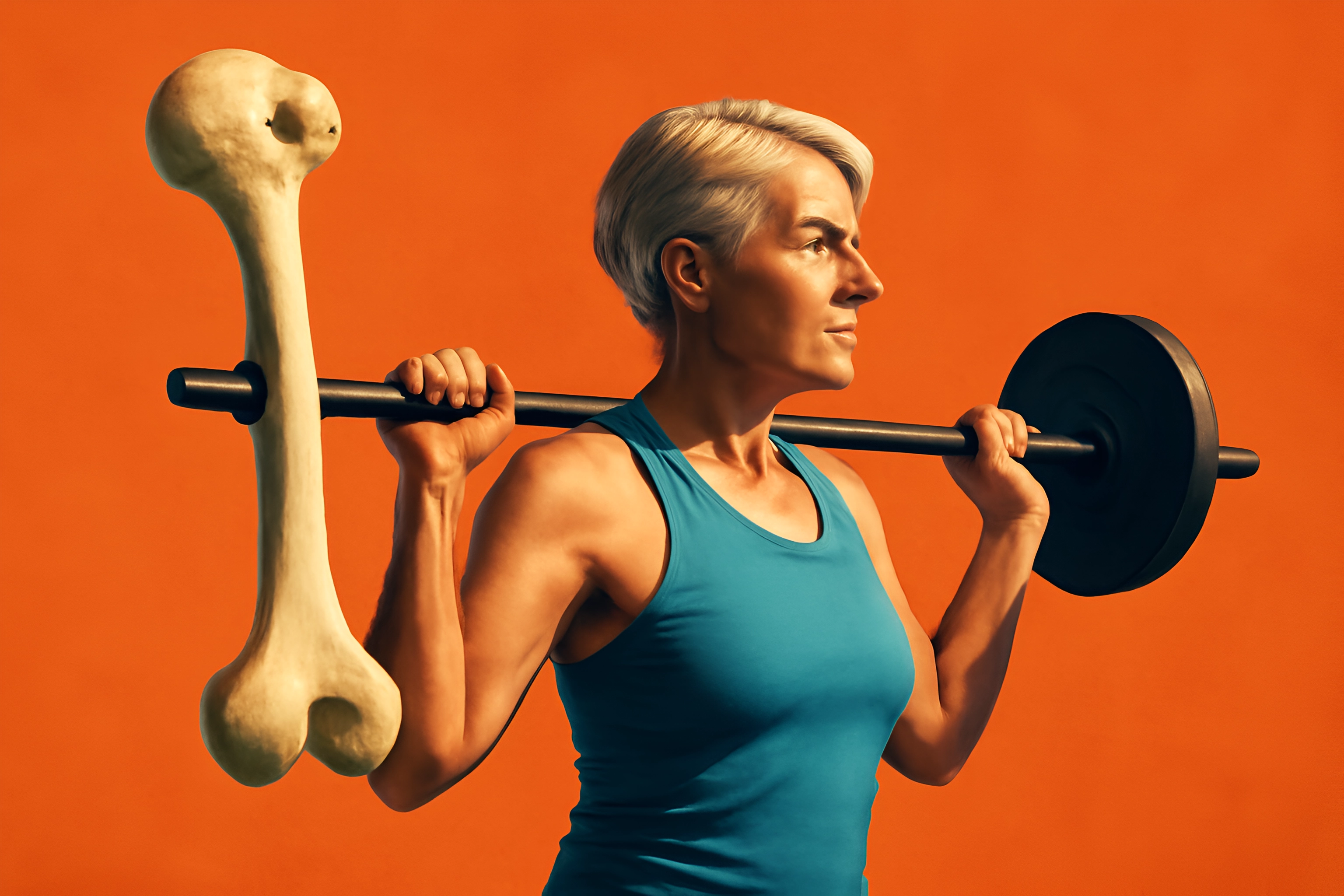
Introduction: Reclaiming Your Movement, One Step at a Time
Remember when climbing a flight of stairs or getting up from a low chair didn't require a second thought? That familiar morning stiffness or the twinge in your knee doesn't have to be your new normal. It’s a signal from your body, but it’s one you have the power to answer.
So many of us over 50 have been told that joint pain is just a part of getting older, an inevitable sentence to a more sedentary life. But that’s a myth we’re here to bust. While joint discomfort is common, surrendering your freedom of movement is not a foregone conclusion.
The truth is, lasting joint health isn't found in a single "magic bullet" pill. It’s forged in the powerful synergy between what you eat, how you move, and the targeted support you provide your body. This is the foundation of a holistic joint health solution for seniors. In this guide, we'll break down the three pillars of joint longevity: an anti-inflammatory diet, smart, joint-friendly exercise, and evidence-based supplements. You'll walk away with a practical action plan to reduce pain, improve mobility, and stay active for years to come.
The Anti-Inflammatory Diet: Your First Line of Defense Against Joint Pain
Think of chronic inflammation as a slow-burning fire inside your joints, causing pain, stiffness, and damage over time. The food you eat can either fan those flames or douse them with powerful, soothing nutrients. Your fork is one of the most effective tools you have in the fight for comfortable, fluid movement.
Making conscious choices about what you put on your plate can fundamentally shift your body’s inflammatory response. It’s not about deprivation; it’s about empowerment. It’s about choosing foods that build you up, protect your cartilage, and quiet the internal noise of inflammation so you can focus on living your life.
This approach is backed by compelling science. Research from Stanford Longevity highlights how certain nutrients, particularly omega-3 fatty acids, can directly intervene in the inflammatory process and help protects joint cartilage cells from inflammation. By focusing on an anti-inflammatory eating style, you are taking direct, daily action to reclaim your comfort and mobility.
Foods That Soothe: Building Your Joint-Friendly Plate
Your grocery cart is your arsenal. Fill it with foods that act like a soothing balm for your joints. Fatty fish like salmon and mackerel are packed with omega-3 fatty acids, which are nature’s most potent inflammation fighters. Walnuts and flaxseeds offer a fantastic plant-based source of these same powerful fats.
Don’t forget the power of produce. Berries, leafy greens like spinach and kale, and vibrant vegetables like broccoli are loaded with antioxidants. These compounds act like cellular bodyguards, protecting your joints from the oxidative stress that contributes to aging and deterioration. For more ideas, explore our guide to anti-inflammatory superfoods for healthy aging.
Finally, embrace healthy fats and powerful spices. Extra virgin olive oil and avocados provide healthy monounsaturated fats, while spices like turmeric and ginger contain compounds that have been studied for their profound anti-inflammatory effects. Making these foods the stars of your plate is a delicious strategy for long-term joint health.
Foods to Limit: Identifying Inflammation Triggers
Just as some foods can calm inflammation, others can ignite it. The primary culprits are often found in processed, packaged goods. Sugar and refined carbohydrates—think white bread, pastries, and sugary sodas—can trigger an inflammatory response throughout the body.
Highly processed and fried foods are also major offenders. These items often contain unhealthy trans fats and advanced glycation end products (AGEs), which are compounds that can promote oxidative stress and inflammation. While an occasional treat is part of a balanced life, making these foods a regular habit can sabotage your efforts to find relief.
Limiting excessive red and processed meats, like bacon and sausage, can also make a significant difference. By consciously reducing these inflammation triggers, you clear the way for healing and allow the joint-soothing foods to do their best work. For a deeper dive, check out our essential nutritional strategies to reduce inflammation for active seniors.
Diet and Exercise for Joint Pain Over 50: A Perfect Partnership
Have you ever worried that exercise will "wear out" your joints? It's a common fear, but it's time to reframe that thinking. The right kind of movement is not the enemy of your joints; it is their most powerful medicine.
Inactivity is what truly harms your joints. When you don't move, the synovial fluid that lubricates your cartilage becomes thick and stagnant, leading to stiffness. Furthermore, the muscles surrounding your joints weaken, forcing the joints themselves to absorb more impact and stress with every step.
Smart, consistent exercise strengthens those crucial supporting muscles, improves your range of motion, and promotes the circulation of nutrient-rich fluid to your cartilage. A landmark 2025 study in Nature on the DO-HEALTH trial found that combining interventions like exercise and omega-3s showed additive benefits for promoting longevity, proving that these pillars work best together.
The 3 Types of Essential Joint Mobility Exercises for Seniors
A balanced routine is key. First, focus on low-impact cardio. Activities like swimming, water aerobics, cycling, and brisk walking get your heart pumping and blood flowing to your joints without the jarring impact of running. For more inspiration, explore these low-impact cardio ideas for heart-healthy exercise.
Second, incorporate strength training. You don't need to be a bodybuilder; simple exercises using your body weight or resistance bands are incredibly effective. Squats, glute bridges, and rows build strong muscles around your knees, hips, and back, turning them into powerful shock absorbers that protect the joints themselves. Learn how to start safely with our guide to practical strength training modifications for seniors with joint pain.
Third, never neglect flexibility and range of motion. Gentle yoga, tai chi, and daily stretching are essential for reducing stiffness and maintaining your ability to move freely and without pain. These practices help ensure your joints can move through their full, intended range, preventing the tightness that leads to compensation and injury. For specific routines, see our guide on customized flexibility and mobility routines for seniors.
Smart Supplementation: Giving Your Joints Targeted Support
Important Note: Always consult with your doctor or a registered dietitian before adding any new supplements to your routine to ensure they are safe and appropriate for you.
While diet and exercise are the undeniable cornerstones of joint health, smart supplementation can play a valuable supporting role. Think of supplements not as a cure, but as a targeted boost to your efforts—a way to provide your body with specific nutrients that can help manage inflammation and support cartilage structure. They are the backup singers, not the lead vocalist.
The world of supplements can be confusing, which is why it's crucial to focus on those backed by scientific evidence. A 2023 review confirmed that while supplements are not a replacement for a healthy lifestyle, certain compounds can help reduce pain and inflammation, improving quality of life for those with joint discomfort.
The goal is to complement your healthy habits, not replace them. When used correctly and under medical guidance, supplements can help fill nutritional gaps and provide an extra layer of defense for your hard-working joints. This strategic approach ensures you're giving your body every possible advantage.
Evidence-Backed Supplements to Discuss with Your Doctor
When you speak with your healthcare provider, there are a few key supplements worth discussing. Glucosamine and chondroitin are two of the most well-known; they are natural components of cartilage and may help support its structure.
Turmeric, or more specifically its active compound curcumin, is a potent anti-inflammatory that has been extensively studied for its ability to reduce joint pain. For best results, look for a formulation that includes black pepper extract (piperine), which dramatically enhances its absorption.
Omega-3 fish oil is another powerhouse, reinforcing the benefits you get from your diet. Research shows that DHA-rich omega-3s can improve cardiovascular markers and muscle quality in older adults, which indirectly supports joint health by improving overall fitness. Finally, don't overlook Vitamin D and Calcium, as strong bones provide the essential foundation for healthy joints.
Bringing It All Together: Your Integrated Plan for Joint Longevity
You now have the three pillars: a soothing diet, smart movement, and targeted support. But the real magic happens when you stop seeing them as separate tasks and start weaving them into the fabric of your daily life. This is where synergy transforms your efforts into lasting results.
Think of your joint health as a three-legged stool. Diet provides the anti-inflammatory building blocks. Exercise strengthens the structure and keeps it moving smoothly. Supplements can help patch up weak spots. For true, unshakable stability, you need all three legs working together in harmony.
Imagine what this integrated approach could feel like. It’s not about a radical, overnight overhaul. It’s about small, consistent choices that build on each other, creating a powerful upward spiral of wellness, mobility, and confidence.
A "Day in the Life" Example
What does this look like in practice? It's simpler than you think.
**Morning:**
- Start with 10 minutes of gentle stretching to ease stiffness.
- Enjoy an anti-inflammatory breakfast like oatmeal with berries and walnuts.
**Afternoon:**
- Go for a 30-minute brisk walk or bike ride.
- Stay hydrated with plenty of water throughout the day.
- Have a lunch rich in leafy greens, lean protein, and avocado.
**Evening:**
- Prepare a dinner of baked salmon with roasted broccoli and quinoa.
- Take your doctor-approved supplements with your meal.
- Wind down with a few relaxing stretches before bed.
Conclusion: Your Journey to Better Movement Starts Today
The path to healthier joints is not about finding a single secret weapon. It is about embracing a holistic philosophy—understanding that the food you eat, the way you move, and the support you provide your body are all deeply interconnected. By combining an anti-inflammatory diet, consistent joint-friendly exercise, and smart, evidence-based supplementation, you create a powerful system of self-care.
Aging with vitality means being proactive. By adopting these holistic strategies, you are not just managing joint pain—you are investing in your freedom, your independence, and your ability to live life to the fullest. It's about progress, not perfection.
What is one small change you are inspired to make for your joint health this week? Share your goal in the comments below—we’d love to cheer you on















